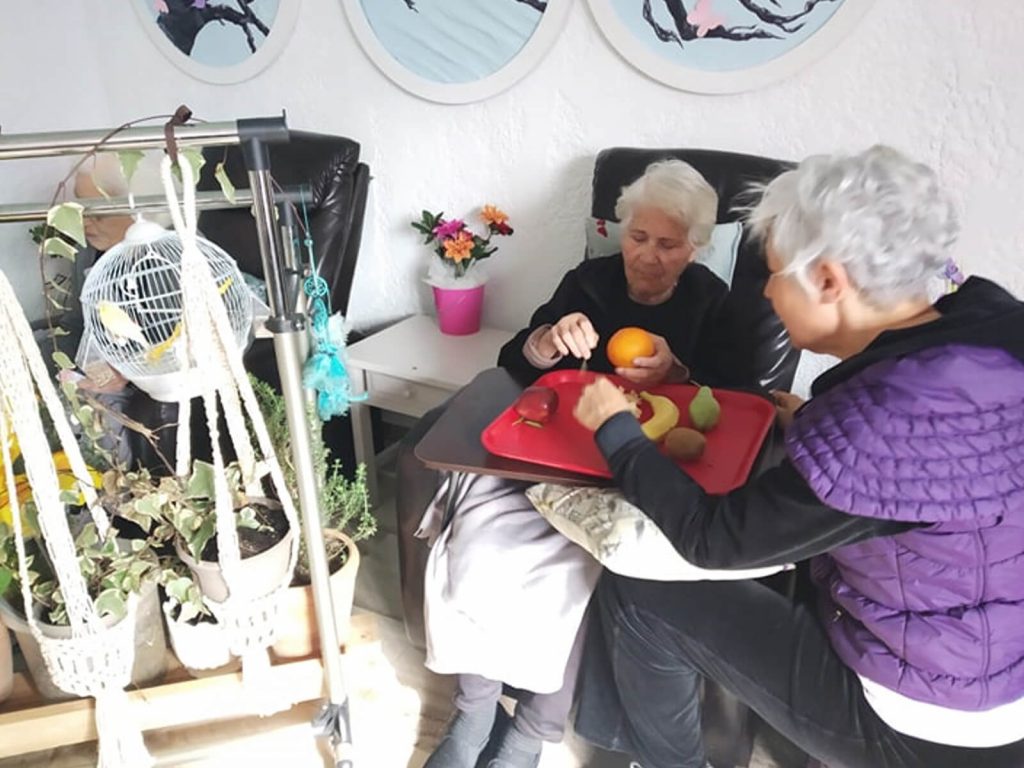At the end of October delegates from the Kwong Yum Care Home of Hong Kong Chinese Christian Churches Union accompanied our Australian Champion, Dr Sara Karacsony of the University of Tasmania, to Minchinbury Manor in Western Sydney. The visitors had travelled to Canberra for the 8th International Conference on Ageing and Spirituality, organised by Charles Sturt University, and to Sydney to learn how to adopt Namaste Care in their hospice setting. Recruited for a research study led by Professor Esther Chang from Western Sydney University in 2010, Minchinbury Manor has the longest running Namaste Care program outside the USA. Lynn Mowbray, Executive Manager of Minchinbury Manor commented “Families are happy to have their loved one in the program and appreciate the non-clinical and ‘cosy’ atmosphere of the dedicated Namaste Care space. Residents who were lost in the system, can be included in Namaste Care. Staff experience fewer demands on their time and are confident that the residents are secure with their needs being taken care of within the program. I am unequivocal that residents receiving Namaste Care are more settled and this reduces the need for antipsychotic medications”.

Aged Care Insite written by Dr Sara Karacsony, School of Nursing, College of Health and Medicine, University of Tasmania, 6 June 2019
More than half of older people living in residential aged care facilities experience dementia. Those people with advanced dementia who can no longer participate in the traditional engagement programs offered within facilities are often socially isolated and without any meaningful daily activities to enjoy. The Namaste Care is a sensory program for people living with advanced dementia in various settings. Developed in 2003 by Joyce Simard, a geriatric social worker and consultant in the USA, this holistic, person-centred care program, which is gaining international momentum, improves quality of life for the person with dementia and provides meaningful connections (activities) for the older person in the presence of others. Adopted from the Indian greeting ‘Namaste’, which means to ‘honour the spirit in you’, the Namaste Care program is offered every day in a quiet, calming environment. Activities of daily living tailored to the individual are provided with a loving touch and include gentle washing and moisturising of the face, (make up for the ladies, if accustomed to wearing) shaving (the ‘old fashioned’ way) hair care, hand and foot washing and massage, and nourishment (as tolerated). The scent of lavender as well as those that reflect different seasons, music and other sensory and tactile objects are features of the program. As many residents involved in Namaste Care have lost the ability to exercise or move freely, range of motion exercises provide touch, help to prevent contractures and improve blood supply. International evidence is emerging about the benefits of the Namaste Care program showing that it reduces behavioural and psychological symptoms of dementia including rejection of care, reduces pain, and improves communication and engagement. The Namaste Care program also impacts positively on staff, increasing job satisfaction, and creates more enjoyable visits for family carers and volunteers. At least two Australian residential aged care facilities have implemented this program as an option for end-of-life dementia care. Recruited for a research study led by Professor Esther Chang from Western Sydney University in 2010 to evaluate the benefits of Namaste Care, Opal (formerly Principal) Shoalhaven received a Better Practice Award in 2011 for resident lifestyle. Minchinbury Manor in Western Sydney is the longest running Namaste Care program outside of the USA. Both facilities see Namaste Care as having a very positive result and benefiting everyone. Lynn Mowbray, Executive Manager of Minchinbury Manor, says that families are happy to have their loved one in the program and appreciate the non-clinical and ‘cosy’ atmosphere of the dedicated Namaste Care space. Staff experience fewer demands on their time and are confident that the residents are secure with their needs being taken care of within the program. Lynn is unequivocal that the residents receiving Namaste Care are more settled and this reduces the need for antipsychotic medications. Namaste carers, or care companions as they are known at Minchinbury Manor, have been providing this approach to care since beginning the program, reflecting the satisfaction that this type of ‘slow’ and ‘loving’ care can provide in care work. Lynn says, “there is a lot of personal giving by staff”; staff generally self-select for Namaste Care and managers are aware of who would be good to be delivering this type of care. With up to 10 residents a day receiving Namaste Care, this dedicated program for end-of-life dementia care has benefits not only for residents and their families, but the whole care team.”

Sara is a Lecturer in Nursing at the Sydney-based campus of the University of Tasmania. Her clinical background is in palliative care nursing in which she has wide-ranging experience across acute, specialist and residential aged care. Sara’s research interests include care of the older person, palliative care and the teaching of palliative care philosophy and principles to nursing students and nurses. Sara’s PhD research through Western Sydney University’s Aged Care and Palliation research stream focused on the residential aged care workforce and palliation. Sara was project officer on the first funded research project in Australia to evaluate Namaste Care in residential aged care facilities. Currently, Sara is leading a project to implement and evaluate the benefits of Namaste Care in an aged care ward within a teaching hospital in Greater Sydney.